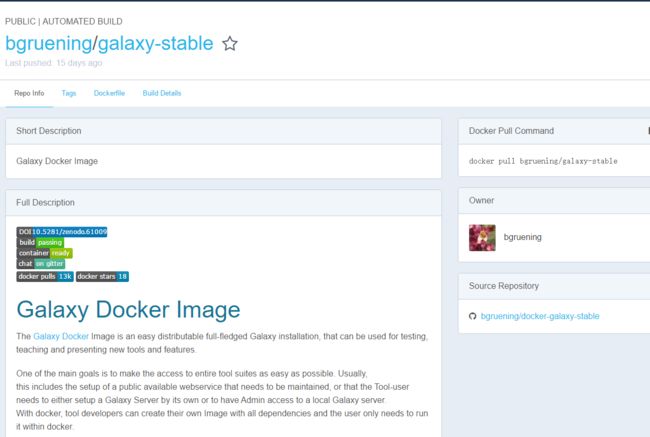前几天再看新买的《python Web开发实践》时发现一个神奇的工具---Docker,官网介绍是
Docker is the world's leading software containerization platform
我不禁想到生物信息学中有许多软件都要在类unix平台上运行,仅有部分移植到Windows上。所以在要想在Windows上运行这些没有移植的软件,要么需要虚拟出一个Linux系统,要不就是利用Windows10上一个新特性--内置ubuntu系统。
所以由于Docker的特性,就多了一种在windows上运行生物信息软件的方法
安装
运行Docker的第一步就是安装。Docker最在仅能在类unix系统运行,后来移植到Windows平台,不过要在Windows上安装Docker也要满足2个要求:
- Windows10 64位
- Hyper V
不满足的话可以用Docker Toolbox替代。
满足以上条件后只要下载InstallDocker.msi并运行就行了。
然后打开powershell,输入一下指令检查是否安装成功
> docker version
> docker-compose --version
> docker-machine --version
如果以上命令都没有报错则安装完成。此外在命令行直接输入docker就会出现docker的参数说明,具体使用方法见后面的案例。
Usage: docker [OPTIONS] COMMAND [arg...]
docker [ --help | -v | --version ]
A self-sufficient runtime for containers.
Options:
--config=%USERPROFILE%\.docker Location of client config files
-D, --debug Enable debug mode
-H, --host=[] Daemon socket(s) to connect to
-h, --help Print usage
-l, --log-level=info Set the logging level
--tls Use TLS; implied by --tlsverify
--tlscacert=%USERPROFILE%\.docker\ca.pem Trust certs signed only by this CA
--tlscert=%USERPROFILE%\.docker\cert.pem Path to TLS certificate file
--tlskey=%USERPROFILE%\.docker\key.pem Path to TLS key file
--tlsverify Use TLS and verify the remote
-v, --version Print version information and quit
Commands:
attach Attach to a running container
build Build an image from a Dockerfile
commit Create a new image from a container's changes
cp Copy files/folders between a container and the local filesystem
create Create a new container
diff Inspect changes on a container's filesystem
events Get real time events from the server
exec Run a command in a running container
export Export a container's filesystem as a tar archive
history Show the history of an image
images List images
import Import the contents from a tarball to create a filesystem image
info Display system-wide information
inspect Return low-level information on a container, image or task
kill Kill one or more running containers
load Load an image from a tar archive or STDIN
login Log in to a Docker registry.
logout Log out from a Docker registry.
logs Fetch the logs of a container
network Manage Docker networks
node Manage Docker Swarm nodes
pause Pause all processes within one or more containers
port List port mappings or a specific mapping for the container
ps List containers
pull Pull an image or a repository from a registry
push Push an image or a repository to a registry
rename Rename a container
restart Restart a container
rm Remove one or more containers
rmi Remove one or more images
run Run a command in a new container
save Save one or more images to a tar archive (streamed to STDOUT by default)
search Search the Docker Hub for images
service Manage Docker services
start Start one or more stopped containers
stats Display a live stream of container(s) resource usage statistics
stop Stop one or more running containers
swarm Manage Docker Swarm
tag Tag an image into a repository
top Display the running processes of a container
unpause Unpause all processes within one or more containers
update Update configuration of one or more containers
version Show the Docker version information
volume Manage Docker volumes
wait Block until a container stops, then print its exit code
Run 'docker COMMAND --help' for more information on a command.
使用Docker搭建Galaxy生物信息平台
首先我们需要确认Docker是否存在这个平台
$ [sudo] docker search galaxy
NAME DESCRIPTION STARS OFFICIAL AUTOMATED
bgruening/galaxy-stable Galaxy Docker Image 18 [OK]
bgruening/galaxy-deeptools 5 [OK]
bgruening/galaxy-rna-workbench 2 [OK]
......
通过NAME这一列我们可以找到所需要的镜像(images)为bgruening/galaxy-stable,也可以去Docker Hub进行查找。
在作者的Docker Hub页面上会有该镜像的具体使用方法。
找到进行之后,就可以通过pull下载该镜像:
> docker pull bgruening/galaxy-stable
随后通过该镜像在本地运行Galaxy服务:
>docker run --name mygalaxy -d -p 8080:80 -p 8021:21 -p 8022:22 bgruening/galaxy-stable
--name xxxx: 指定该容器名,否则随机生成
-d : 作为一种服务在后台运行
-p 外部端口:内部端口 : 将外部端口绑定到内部端口,实现从浏览器访问Galaxy
在浏览器输入localhost:8080,就可以访问了。
当然我们可能还需要在Galaxy中添加管理,修改配置,这时候就需要交互式的运行docker。
docker run -i -t bgruening/galaxy-stable /bin/bash
更详细的了解如何管理服务
光是学会安装运行还不够,我们还需要了解服务的运行状态,这里就要介绍另外几个command: ps, top, logs, port
> docker ps -l #可以查看最近运行的服务
> docker port mygalaxy # 查看mygalaxy的端口转发
> docker logs mygalaxy # 了解mygalaxy的运行日志
> docker top mygalaxy # 了解mygalaxy的运行进程
如何想暂停服务该怎么办?暂停之后有需要重新开启呢?
>docker stop mygalaxy
>docker start mygalaxy
卸载Galaxy
当你用了Docker版的Galaxy后感觉还是不太适合,那应该如何卸载呢?首先是停止服务,然后删除容器,然后删除镜像.
docker stop mygalaxy
docker rm mygalaxy
docker rmi bgruening/galaxy-stable
总结
本文主要介绍了一种在Windows上搭建Galaxy的一种方法,介绍Docker的几个指令:search, pull, run, ps, port, top, logs, stop, start等指令,更多Docker和Galaxy相关内容请翻阅参考资料。
参考资料
https://docs.docker.com/docker-for-windows/
https://hub.docker.com/r/bgruening/galaxy-stable/


